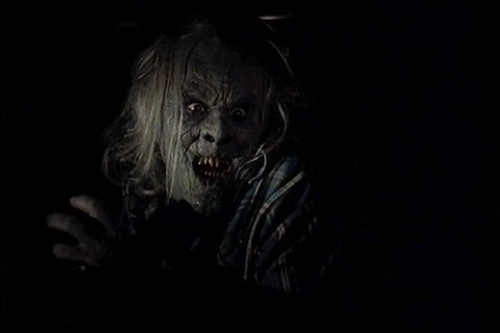
"You unlock this door with the key of imagination. Beyond it is another dimension. A dimension of sound. A dimension of sight. A dimension of mind. You're moving into a land of both shadow and substance of things and ideas. You've just crossed over into... The Twilight Zone."
Ever since studying the basics of postmodern film, every film I now encounter appears to self-consciously either reference itself or the artificiality or its substance. Just like Fright Night which was visited in yesterday's blogpost, The Twilight Zone: The Movie (nice title) opens with a cheeky nod to both the source material and the present text.
Dan Aykroyd and Albert Brooks are buddies on a midnight road trip, although I presume they are not playing themselves so shall henceforth be referred to as Buddy 1 and Buddy 2. Buddy 1 asks Buddy 2, "Did you ever watch The Twilight Zone," thus veering us into a world where we expect the unexpected. The mere mention of the Twilight Zone has interrupted a ostensibly genial scene. The tone is now loaded with suspense, now even more heightened than the previous game of chicken that Buddy 2 was playing as the driver of the car.
 |
| Want to see something realllly scary? |
When Buddy 1 goes full demonic, it is clear we've entered into the Twilight Zone.
The movie is comprised of four segments, along with the aforementioned prologue and an epilogue, directed by John Landis, Steven Spielberg, Joe Dante, and George Miller respectively.
The first two segments are weak in comparison to the crescendo that builds once Joe Dante's segment begins.
"Time Out" by Landis takes a modern racist and sexist who beliefs are finally compromised and submerges him into another dimension where he is victim of prejudiced thought. He journeys through Nazi Germany, a KKK ruled South, and American-occupied Vietnam. The protagonist's patriotic rage critiques American inconsistencies. Landis's segment is so weighted with political allegory that it forgets to establish the eery tone synonymous with the Twilight Zone series.
While "Time Out" lost sight of its genre intent, "Kick the Can" by Steven Spielberg appears to have lost the memo completely. It's classic Spielberg, where sentiment drenches our eyes and ears and hearts. The score soars as two favourite devices of nostalgia are manipulated for the love of film. Juxtaposed here are childhood innocence and old-age loneliness. Children and the elderly are exploited for their seemingly fragile sensibilities. It takes the poignant blueprint of Peter Pan and rams it off a wall until it is deranged. It is whimsical and cute but trite in comparison to the fantastical and horror potential that the subsequent segments offer, and inadequate for the Twilight Zone oeuvre.
 |
| Creepy Damien surrogate in "It's a Good Life." |
It is a relief to leave the Spielberg hallmark moment behind. Joe Dante's "It's a Good Life." Like "Time Out," it resembles a work of social commentary, in an world eschew where a young boy seems to rule proceedings. Cartoons, where there is a promise that anything can happen, form a motif. The combination of cartoon imagery and sinister plot make for a macabre experience. This is Burtonesque before Tim Burton really was.
The grand old adage of saving the best for last has never been more accurate. John Lithgow spiraling into a psychotic panic in George Miller's "Nightmare at 30,00 feet" is what cinema was made for. Add to that a cramped airplane, a storm, and some goblin of sorts and people, we have a movie! The epilogue that quickly follows is the perfect bookend to the piece, and redeems the movie.
 |
| See. Burtonesque. |
 |
| Lithgow. |
It's been described as horror, and while there are horror elements used, this is more of a warped fairytale. Drama that exams the distortion of mind and society rather than the disintegration of relationships.
No comments:
Post a Comment